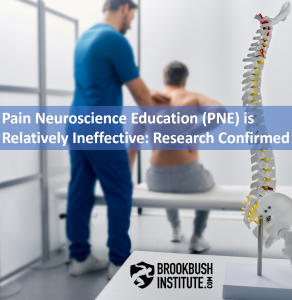
Review and Commentary on the Comparative Studies Investigating Pain Neuroscience Education
— Dr. Brent Brookbush, CEO of Brookbush Institute
NEW YORK, NY, UNITED STATES, February 8, 2024 /EINPresswire.com/ — The following is quoted from the new article (and research review) by the Brookbush Institute: Pain Neuroscience Education (PNE) is Relatively Ineffective
PAIN SCIENCE HAS A PROBLEM: Pain science research currently has an interesting problem. It is amazing work, by incredible professionals, that has helped to inform theoretical frameworks on physical rehabilitation. However, the relatively strong correlations made between pain and psychosocial factors (demonstrated in some research studies), have resulted in a focus on addressing these psychosocial factors with cognitive interventions. The problem is these cognitive approaches do not have a large effect on the factors they are attempting to address, and worse, changes in cognitive factors seem to have little if any effect on objective outcome measures (e.g. pain-free range of motion, neck disability index scores, etc.). At the very least, these cognitive approaches are far less effective than manual therapy, specific exercise, and other effective modalities. Author’s note, it seems that a surge in the amount of research published on pain science was highjacked by a relatively ineffective application of that research (e.g. pain science education (PNE)). Worse still, some individuals have asserted that this surge in research and popularity of PNE programs is evidence of PNE being “new and better” while discrediting other more effective modalities. This type of strategy has won political campaigns, but it is not evidence-based practice…
RESEARCH SUMMARY STATEMENT: The randomized controlled trials (RCTs) available that compare pain neuroscience education (PNE) to other interventions imply that PNE is unlikely to be more effective than biomedical education, and is unlikely to result in additional benefit when added to supervised manual therapy, exercise, and/or the combination of other effective interventions. Further, the addition of manual therapy and exercise to PNE reliably results in significant improvement in patient outcomes, implying that PNE alone cannot be considered an optimal treatment approach. The addition of PNE to a home exercise program may enhance patient outcomes (perhaps due to enhanced effort and compliance during exercise). Last, PNE does reliably improve Tampa Scale of Kinesiophobia (TSK) scores; however, the validity of this finding and/or correlation with other recovery outcome measures is questionable.
– Of the 10 studies (cited below) in this review comparing similar intervention plans with and without PNE, 4 studies demonstrate no difference, 3 studies only demonstrate a significant difference in TSK scores, and 3 studies exhibit significant improvements in 1 additional outcome measure. Unfortunately, the additional outcome measures are likely statistical variance, as these measures may also be influenced by subjective or cognitive factors (FABQ and Pain), each study only exhibited 1 additional difference (of many outcome measures), and each difference was only noted during reassessment during 1 time-point (of many). In short, the gross majority of comparative research demonstrates that PNE is not reliably effective for improving objective patient outcome measures.
For the rest of this article, complete systematic review, and full bibliography check out: Pain Neuroscience Education (PNE) is Relatively Ineffective: Research Confirmed
10 Studies Comparing Interventions With and Without Pain Neuroscience Education (PNE)
1. Derebery, J., Giang, G. M., Gatchel, R. J., Erickson, K., & Fogarty, T. W. (2009). Efficacy of a patient-educational booklet for neck-pain patients with workers’ compensation: a randomized controlled trial. Spine, 34(2), 206-213.
2. Lluch, E., Duenas, L., Falla, D., Baert, I., Meeus, M., Sanchez-Frutos, J., & Nijs, J. (2018). Preoperative pain neuroscience education combined with knee joint mobilization for knee osteoarthritis. The Clinical journal of pain, 34(1), 44-52.
3. Matias BA, Vieira I, Pereira A, et al. Pain neuroscience education plus exercise compared with exercise in university students with chronic idiopathic neck pain. Int J Ther Rehabil. 2019;26:1–14.
4. Pardo, G. B., Girbés, E. L., Roussel, N. A., Izquierdo, T. G., Penick, V. J., & Martín, D. P. (2018). Pain neurophysiology education and therapeutic exercise for patients with chronic low back pain: a single-blind randomized controlled trial. Archives of physical medicine and rehabilitation, 99(2), 338-347.
5. Poulsen, E., Hartvigsen, J., Christensen, H. W., Roos, E. M., Vach, W., & Overgaard, S. (2013). Patient education with or without manual therapy compared to a control group in patients with osteoarthritis of the hip. A proof-of-principle three-arm parallel group randomized clinical trial. Osteoarthritis and Cartilage, 21(10), 1494-1503.
6. Saracoglu, I., Arik, M. I., Afsar, E., & Gokpinar, H. H. (2022). The effectiveness of pain neuroscience education combined with manual therapy and home exercise for chronic low back pain: A single-blind randomized controlled trial. Physiotherapy Theory and Practice, 38(7), 868-878.
7. Beltran-Alacreu, H., López-de-Uralde-Villanueva, I., Fernández-Carnero, J., & La Touche, R. (2015). Manual therapy, therapeutic patient education, and therapeutic exercise, an effective multimodal treatment of nonspecific chronic neck pain: a randomized controlled trial. American journal of physical medicine & rehabilitation, 94(10S), 887-897.
8. Richter, M., Rauscher, C., Kluttig, A., Mallwitz, J., & Delank, K. S. (2020). Effect of additional pain neuroscience education in interdisciplinary multimodal pain therapy on current pain. A non-randomized, controlled intervention study. Journal of Pain Research, 2947-2957.
9. Téllez-García M, de-la-Llave-Rincón AI, Salom-Moreno J, Palacios-Ceña M, Ortega-Santiago R, Fernández-de-las-Peñas C 2014 Neuroscience education in addition to trigger point dry needling for the management of patients with mechanical chronic low back pain: A preliminary clinical trial. Journal of Bodywork and Movement Therapy 19: 464–472.
10. Pires, D., Cruz, E. B., & Caeiro, C. (2015). Aquatic exercise and pain neurophysiology education versus aquatic exercise alone for patients with chronic low back pain: a randomized controlled trial. Clinical Rehabilitation, 29(6), 538-547.
Brent D Brookbush
Brookbush Institute
email us here
Visit us on social media:
Facebook
Twitter
LinkedIn
Instagram
YouTube
TikTok
![]()



